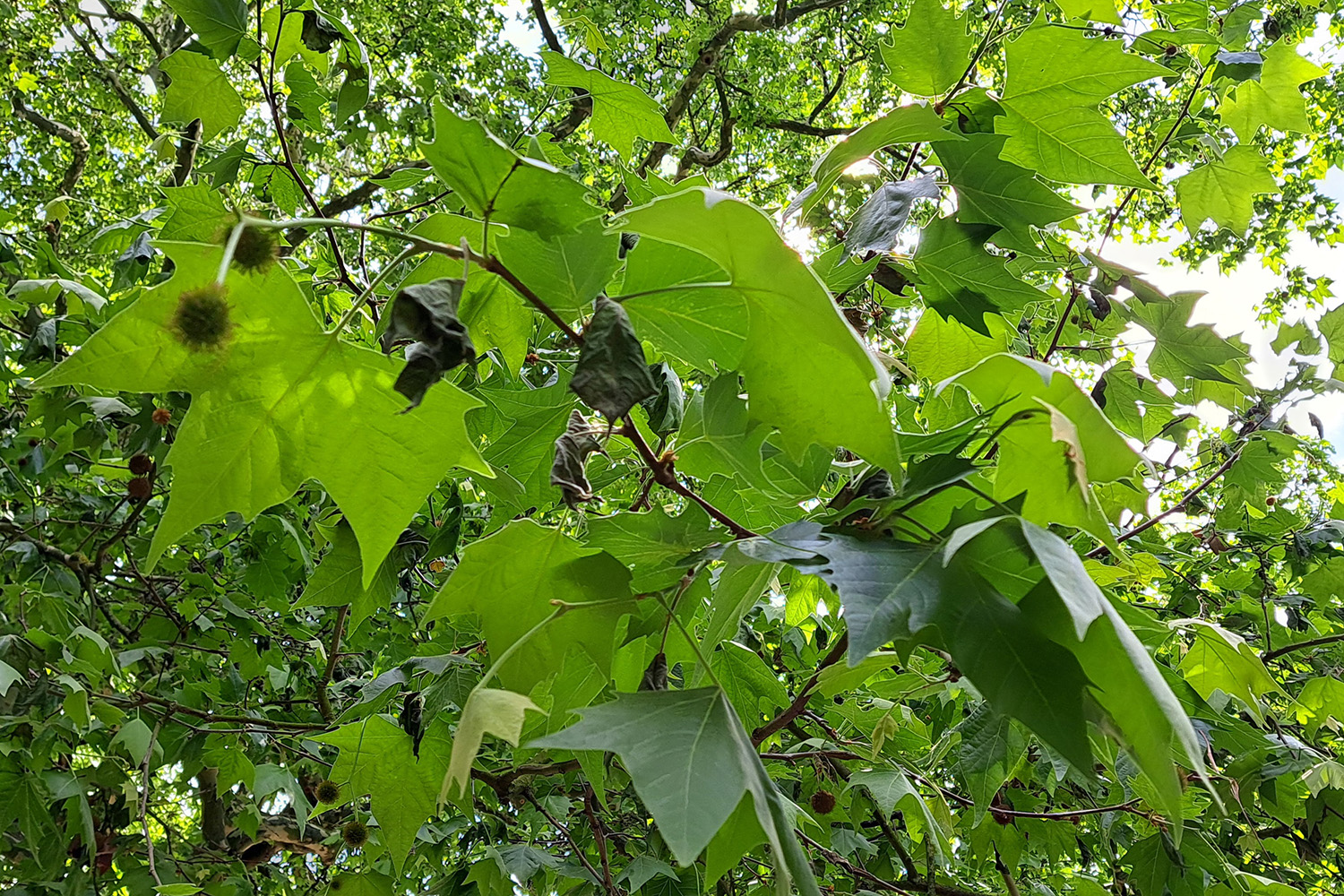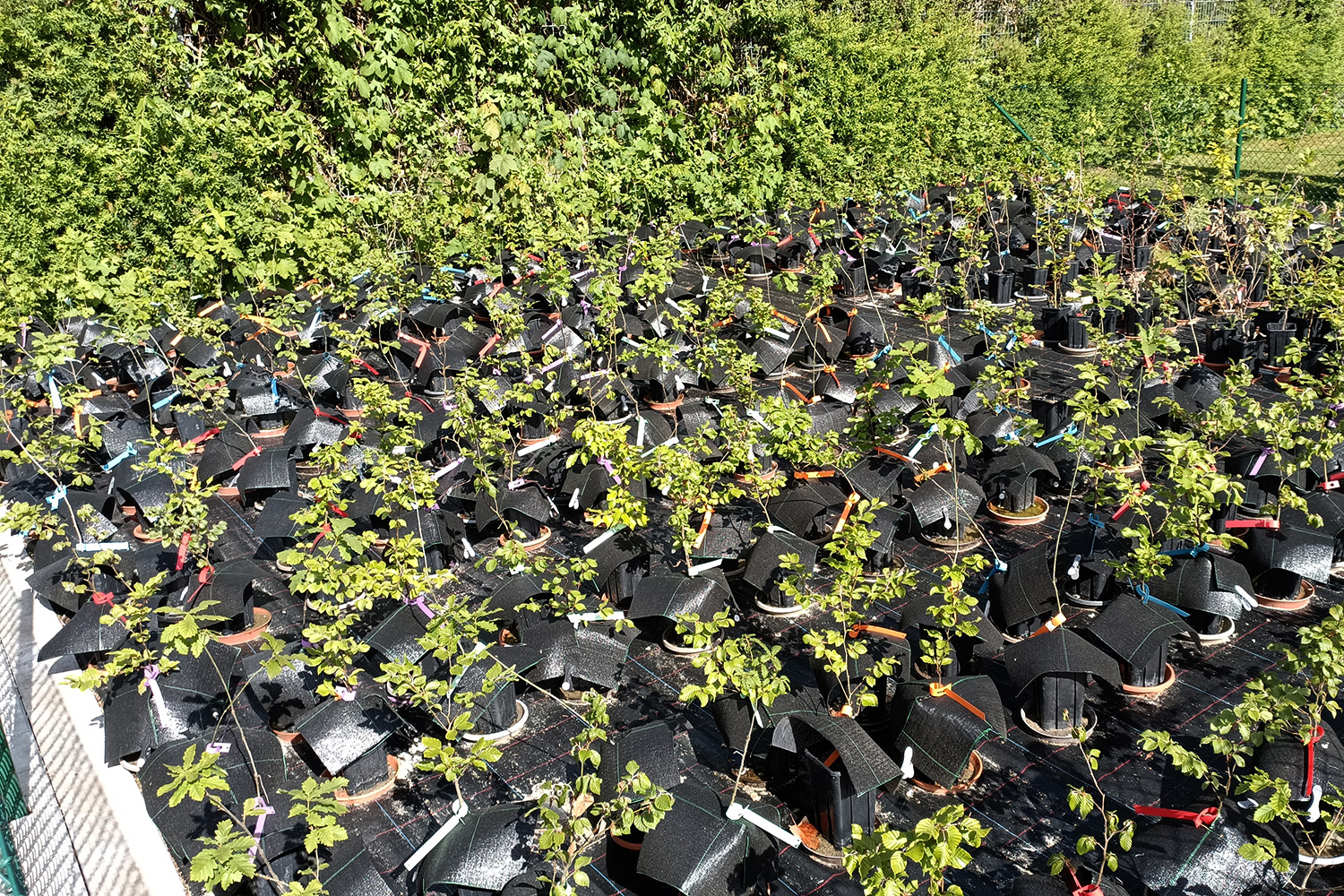When trees suffer What falling leaves tell us about the climate crisis
Increasingly, heat, drought and nutrient deficiency are affecting our trees, as can be seen in urban areas of Braunschweig, such as around the Katharinen-Mensa, as well as in our forests. Researchers at Technische Universität Braunschweig are investigating how the resilience of native tree species can be strengthened through targeted nutrient supplementation. Their work demonstrates that climate change is already a reality, sometimes with dramatic consequences for our vegetation.

Urban trees in particular are already losing leaves on a massive scale due to the severe drought – here, plane trees in front of the Katharinen-Mensa in Braunschweig. Image credit: Institute of Plant Biology/TU Braunschweig
The long-awaited rain has finally arrived. After several months without significant rainfall, it was long overdue, as many of the city’s trees are already showing clear signs of drought stress. Just under 40 mm of rain fell in the Braunschweig area over the last three months, which is around a quarter of the usual amount. Usually, around 160 mm would be expected during this period. This prolonged drought is having a significant impact on local vegetation. Trees are showing increasing signs of stress, such as premature leaf fall and reduced vitality. Urban trees are particularly affected by severe soil sealing and compaction. This is particularly noticeable on the plane trees in front of the Katharinen Mensa, where hundreds of fallen leaves can be seen on the ground. Dead leaves are also visible in the tree crowns, which is a clear warning sign.

Individual leaves are already drying up in the dense canopy of the trees. Image credit: Institute of Plant Biology/TU Braunschweig
Forests in transition: The health of our trees
Our forests are under pressure, not just in isolated areas but across the board, and increasingly dramatically. Climate change is no longer just a future possibility, but a present reality even in Central Europe. In Germany, for example, the average annual temperature has risen by around 2°C since 1881 – well above the global average. This has been exacerbated in recent years by repeated extremely hot and dry summers and dry winters. Snow, which used to fall reliably in our region and create important water reserves, is now often absent.
Consequently, soils dry out deeply not only in summer, but in spring too. Beech, oak and other native deciduous trees are particularly under existential stress, especially when located in urban or shallow areas. Water scarcity reduces growth and weakens the immune system of trees.
At the same time, pests and pathogens are taking advantage of the situation. Bark beetles and insects such as the oak processionary moth and the gypsy moth, which are originally from southern regions, have become well established in northern Germany due to warming. They cause massive damage in some cases. Pathogenic fungi such as Diplodia shoot blight in pine trees and Phytophthora in beech trees are also spreading more widely. These organisms benefit from the warm, dry climate and find weakened hosts.

Beech trees here on the grounds of the Thünen Institute in Braunschweig show severe damage or are dying completely. Image credit: Institute of Plant Biology/TU Braunschweig
These developments demonstrate that forests face threats from multiple sources, including heat, drought, pests and nutrient deficiencies. The effects range from premature leaf loss and crown damage to the death of entire stands of trees. The latest Forest Condition Report reveals that only one in five trees in Germany is considered healthy. The global climate crisis is therefore hitting Central Europe’s forests with full force – and with them, an indispensable ecosystem. Climate-adapted, site-appropriate, and nutrient-sensitive forest management is therefore more urgent than ever.
Sulphur deficiency: an underestimated factor
However, it’s not just water that’s in short supply. Essential nutrients, such as sulphur, have also become scarce. Stricter air pollution control laws have drastically reduced the once abundant supply of sulphur in the atmosphere, with noticeable consequences for many plants that depend on an adequate sulphur supply to defend themselves against increasingly successful pathogens. Sulfur deficiency was first identified in agricultural crops in the mid-1990s and has since been the subject of extensive research. Nowadays, farmers address this issue by regularly applying sulphur according to the crop being grown.
Research in action: The sulphur project at TU Braunschweig
This is where a current research project by the Stress Physiology Working Group at the Institute of Plant Biology at Technische Universität Braunschweig comes in. In collaboration with the Julius Kühn Institute and other partners, including the Lower Saxony State Forestry Department and the Söhlde lime works, the researchers are investigating whether the targeted application of sulphur can enhance the stress resistance of native tree species, such as beech and oak. Through complex pot and field experiments, they are examining the impact of sulphur deficiency on plant health and exploring the potential of sulphur fertilisation to enhance resilience to drought and pests.

Test area in the extension of the Botanical Garden: Young beech and oak trees in pot experiments with varying amounts of sulphur added. Image credit: Institute of Plant Biology/Technical University of Braunschweig
A glimpse into the future: sustainable forest management
The results of this research could transform future forest management. Understanding the complex interactions between nutrient availability and tree health will enable us to develop targeted measures to make our forests more resilient to the challenges of climate change.
Authors: Dr. David Kaufhold and Prof. Robert Hänsch, Institute of Plant Biology, TU Braunschweig
